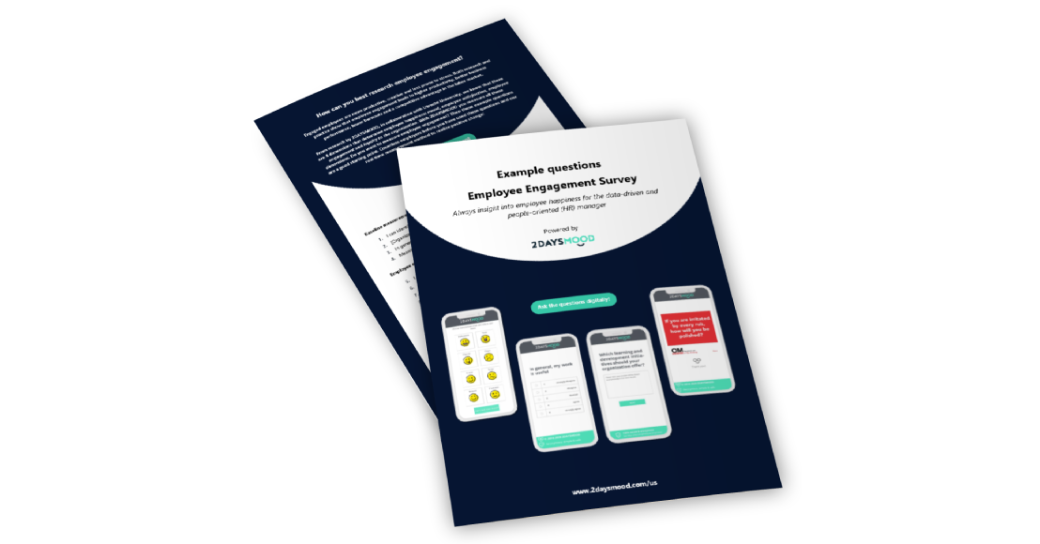Chart employee happiness quick & easy: download the ESS sample

By Kirsten van Enk | 26/05/2023
In a modern work environment, employee happiness is essential for the optimal performance of your employees and therefore the success of your organization. If employees experience happiness at work, they will be more productive, more involved with your organization and will achieve better results. To chart the state of happiness of your employees, we would like to give you a hand. Therefore, we have put together a sample ESS (employee satisfaction survey) with to the point questions that take stock of how happy your employees are.
The focus of today’s work environment is no longer just about hierarchical structures and formal work processes. Instead, today we pay much more attention to flexibility, autonomy and creating a positive work culture. This recognizes much more the value of employees, and their well-being is a crucial factor in this.
Sample: getting started with an ESS
Many organizations annually survey their employees on how they are doing as an employer. What do employees think is going well? Where is there still room for improvement? By doing this kind of ‘static’ measurement, you are actually way behind. By the time the results are in and can be analyzed, the measurement has already been taken weeks (or even months) ago. Is it still relevant then?
Therefore, 2DAYSMOOD proposes a new method: the MTO 3.0. A short-cycle, effective measurement in which employees are regularly asked for input and feedback. This also makes it much easier to measure the moods of employees and thus chart happiness at work.
Download the sample ESS here!
Why a sample ESS?
Employee happiness is often seen as a ‘soft’ concept – the elusive, unmeasurable side of HR. While it does have a huge effect on the performance of employees, their commitment and the general health of the organization. At 2DAYSMOOD, we know that happiness at work is not unmeasurable. Using the Employee Happiness Model, you can map, monitor and optimize work happiness in your organization.
But setting up an ESS is not so easy. Perhaps you are not sure where to start. We would like to help you with that: we have listed a number of sample ESS questions with which you can quickly and simply begin to take stock of happiness at work in your organization. These sample ESS questions are based on a validated questionnaire. So we’re not just throwing some questions at you: there is science and research behind them.
Advantages short-cycle ESS
Are you still conducting annual employee satisfaction surveys with your employees? And are you looking for a way to make it faster, easier and more fun? This is why a short-cycle ESS delivers more and takes less time.
1. Real-time feedback
Short-cycle surveys allow organizations to gather real-time employee feedback. Instead of waiting for an annual survey, you can gain continuous insight into employee satisfaction. This allows you to respond quickly to any issues, trends or opportunities that arise.
2. Quick identification of problems
With regular and short surveys, you can quickly identify potential problems. If certain aspects of the work environment receive negative feedback, you can take immediate action to improve it. This prevents problems from going unnoticed and piling up, which can ultimately affect employee satisfaction and performance.
3. Targeted improvement actions
Short-cycle surveys provide detailed insights into specific aspects of the work environment. This allows you to design targeted improvement actions based on the feedback you receive. Instead of implementing general and broad initiatives, you can address specific challenges and provide customized solutions that actually improve employee satisfaction.
4. Higher response rates
Short surveys require less time and effort from employees, which can lead to higher response rates. Employees are more likely to participate regularly in short surveys than in long, time-consuming surveys. This results in greater participation and a more representative picture of employee satisfaction within the organization.
5. Flexibility and adaptability
Short-cycle surveys offer flexibility and adaptability to organizations. They can quickly adapt the questions and themes in the surveys to changing circumstances, new priorities or specific objectives. This allows them to measure specific aspects of the work environment that are relevant to the organization at the time.
6. Improved engagement
Giving employees regular opportunities to provide feedback makes them feel more involved in the organization. They perceive that their opinions count and that action is taken based on their feedback. This can increase employee engagement and loyalty, which in turn can boost productivity and talent retention.
Make use of a sample ESS
Enough reasons to find out whether a short-cycle MTO suits your organization. Would you like to do a first test? Then you can use our sample mto, in which you get practical, scientifically based questions to map the happiness at work of employees.